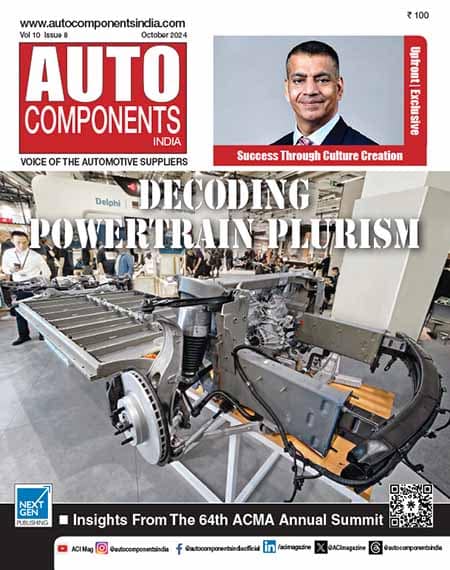By: Suresh Komirishetty, CIO of Mercedes-Benz India and Sri Karumbati, Head of technology committee of ACMA, CIO – SSS Group
We all are witness to a revolution fueled by intelligent digital technologies. The automotive industry is undergoing a transformation on a scale, not see since its founding. The consumer who necessarily had to own an automobile now has a choice between owning and time-sharing, thanks to a slew of digital technologies. The hydrocarbon that has powered the drivetrain for the last century is being replaced by metals like lithium controlled by algorithms. Mechanical components are giving way to electrical and electronic subsystems, perhaps 3D printed as become more prominent. Connected and autonomous automobiles provide a differentiated layer of experience that is creating greater economic value than the product itself. Vehicles are becoming computers on wheels some with 100 million lines of software code, about 8 times that of a Boeing jet. In little over a decade from now digital technology content would make up half the value of an automobile!
A major factor driving the change is the convergence of multiple digital technologies offering new forms of conveniences to consumers at favorable economics. The cost and availability of computing power, storage, and connectivity has dropped precipitously over the years. Form factor of hardware has evolved significantly making it possible for systems to be embedded pretty much anywhere. Data, the new oil, is generated in abundance. More importantly the pool of talented researchers and engineers has become global.
The future automobile and the activities that produce it are going to be highly technology driven resulting in structural changes to the industry. Revenue pools will shift to firms who either have developed or have access to key digital technologies, making technology firms an important part of the value chain perhaps at the expense of incumbent firms. The expected changes are so big that existing firms need to worry about not becoming the next Kodak & Nokia of the Automotive Industry!
But where there is change, there is opportunity. The transformation that is underway presents a rare window to discover and innovate new products and services at global scale. India with its large automotive market and technical talent pool is well positioned to capitalize on. At 25 million vehicles per year the Indian Automotive Industry is the 3rd in size globally. It is the largest two wheeler market in the world. It has a thriving information technology industry which pretty much invented outsourcing at scale. It is the home to hundreds of R&D centers of global firms. It is also the home to thousands of technology startups including some unicorns.
Yet, the contrast is stark when we compare the potential with reality. Almost all the major digital technologies that are disrupting the industry continue to originate from abroad. R&D investment, foundational to innovation, is stagnant at 0.6% of the GDP as opposed to China’s which is at 12.3%. The quantum of patents (by India patent office to local firms) stands at just 10% of the total. Of the top 100 global technology firms only are 5 Indian and that too in the traditional IT space. The large automotive market and technology talent present locally, unfortunately, has not translated into commensurate results.
The primary reason for the dissonance is evident. Developing key digital technologies involves a herculean effort. It requires varying combination capability and risk capital which most firms in the industry do not possess. To be a meaningful part of the digital ecosystem preferably shaping the evolution, investment and capability at scale are necessary. For certain technologies the scale needed is so huge that no single firm can drive the change. Besides some changes require participation of other firms and industries adding layers of complexity. The directional possibilities are so many for any one firm to handle. Attempting to address these challenge, each company by itself, is not a realistic model for India.
A pragmatic solution for the industry is Open Innovation and Collaboration
Open Innovation as a concept is not new, but it is rarely prevalent in the automotive industry. Rather than exclusively relying on resources within organization, Open Innovation calls for harnessing ideas from the world outside. A single organization cannot possibly be the see all and know all for innovation. Ideas reside in unexpected places and such ideas are waiting to be sourced. Problems and challenges of certain kind get opened up to an army of experts from across the globe resulting in multiple solution options that the firm posing the challenge can pursue. Such variety and speed cannot be achieved by relying only on internal resources. It is time to cross the self-imposed corporate boundaries and adopt open innovation.
The concept of collaboration is not new either. Collaboration makes sense where industry level scale and standardisation are required and where differentiation is not a consideration. Outcomes of industry wide collaboration lifts entire industries making them more competitive than their counterparts. Examples use cases of collaboration include forming standards for data exchanges (like autoDX) for blockchain, data security policies and protocols, industry level big data analytics and interfaces for IoT edge devices.
Despite the apparent benefits, established firms are conservative when it comes to concepts like Open Innovation and Collaboration. The traditional approach is to pursue only proven and established paths. But this mindset has to change. By joining hands with Industry bodies firms can create industry level open innovation and collaboration platforms focussed on automotive industry. This will accelerate the pace of technology development.
If India is to become the hub of automotive technologies, actions and policies that promote the advancement of technology development must be accorded the highest priority. In this journey every organization in the automotive ecosystem has a role to play. What the automotive industry is about to undergo is too important a transformation that India can choose to be indifferent to. It is time for thought and action beyond the four walls of the factory, literally!















